Root Cause Analysis and Intervention Strategies for CRE Infection
VerifiedAdded on 2023/06/08
|8
|2203
|147
Report
AI Summary
This report investigates a Carbapenem-resistant Enterobacterales (CRE) infection outbreak in the M8 post-fall unit of a healthcare facility. The root cause analysis identifies urinary catheters and cross-contamination by healthcare staff as primary factors. Recommendations include enhanced hygiene protocols, single-patient rooms, and comprehensive infection control programs with clear responsibilities for all staff. The report outlines a plan for monitoring and reassessing interventions, emphasizing data collection, staff training, and the use of statistical tools. The goal is to minimize errors, ensure patient safety, and improve health outcomes through standardized, quality care, with nurses, doctors, and other healthcare staff playing distinct roles in preventing the spread of infection.
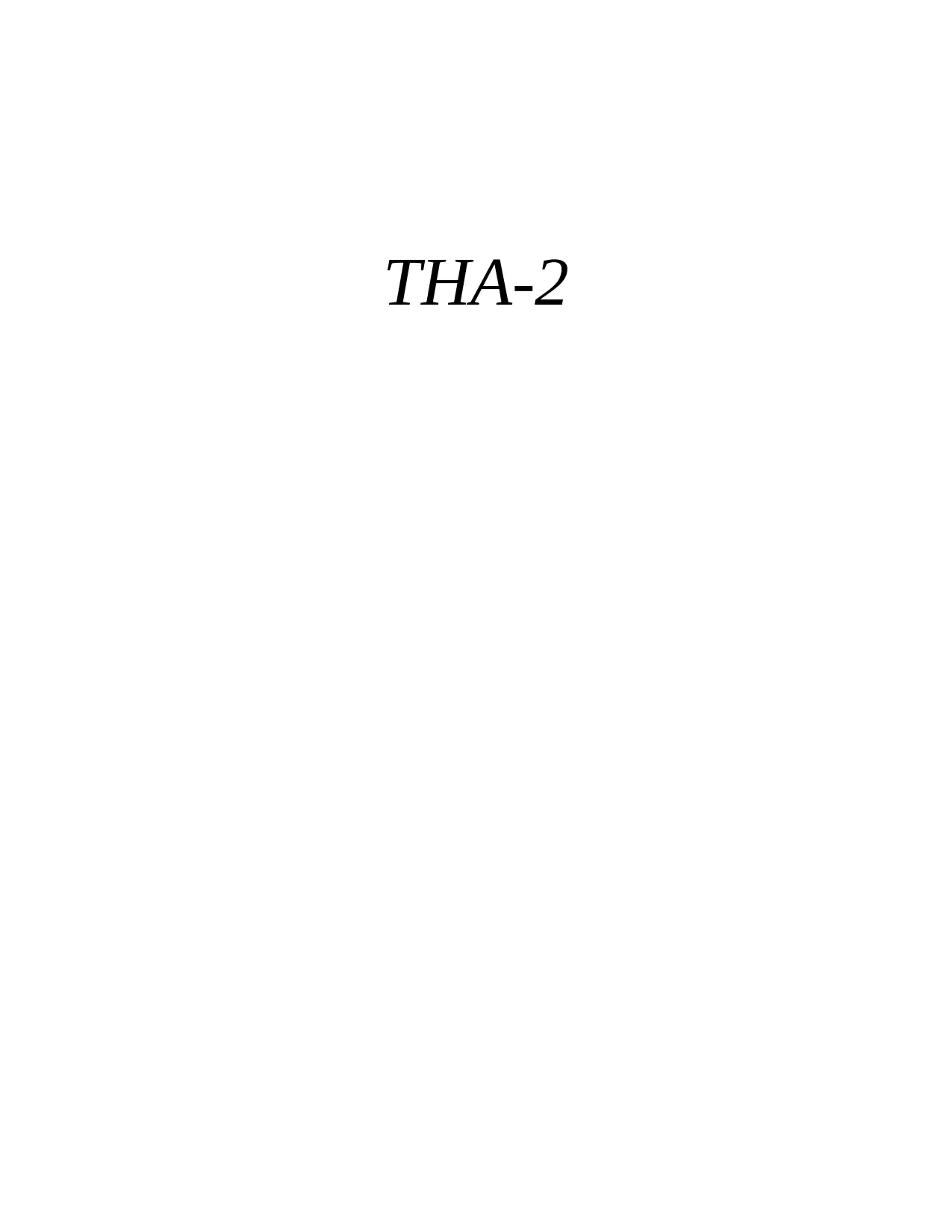
THA-2
Paraphrase This Document
Need a fresh take? Get an instant paraphrase of this document with our AI Paraphraser
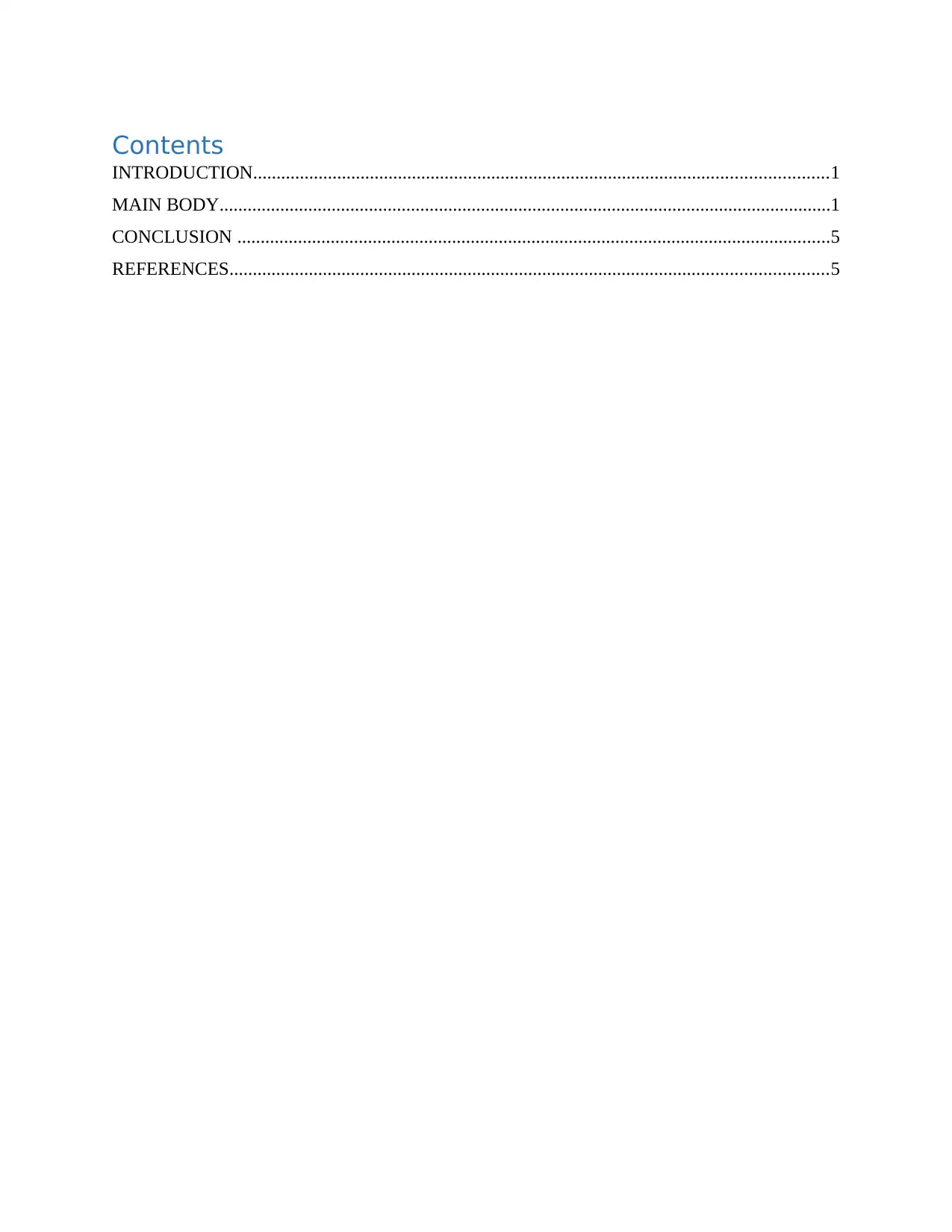
Contents
INTRODUCTION...........................................................................................................................1
MAIN BODY...................................................................................................................................1
CONCLUSION ...............................................................................................................................5
REFERENCES................................................................................................................................5
INTRODUCTION...........................................................................................................................1
MAIN BODY...................................................................................................................................1
CONCLUSION ...............................................................................................................................5
REFERENCES................................................................................................................................5
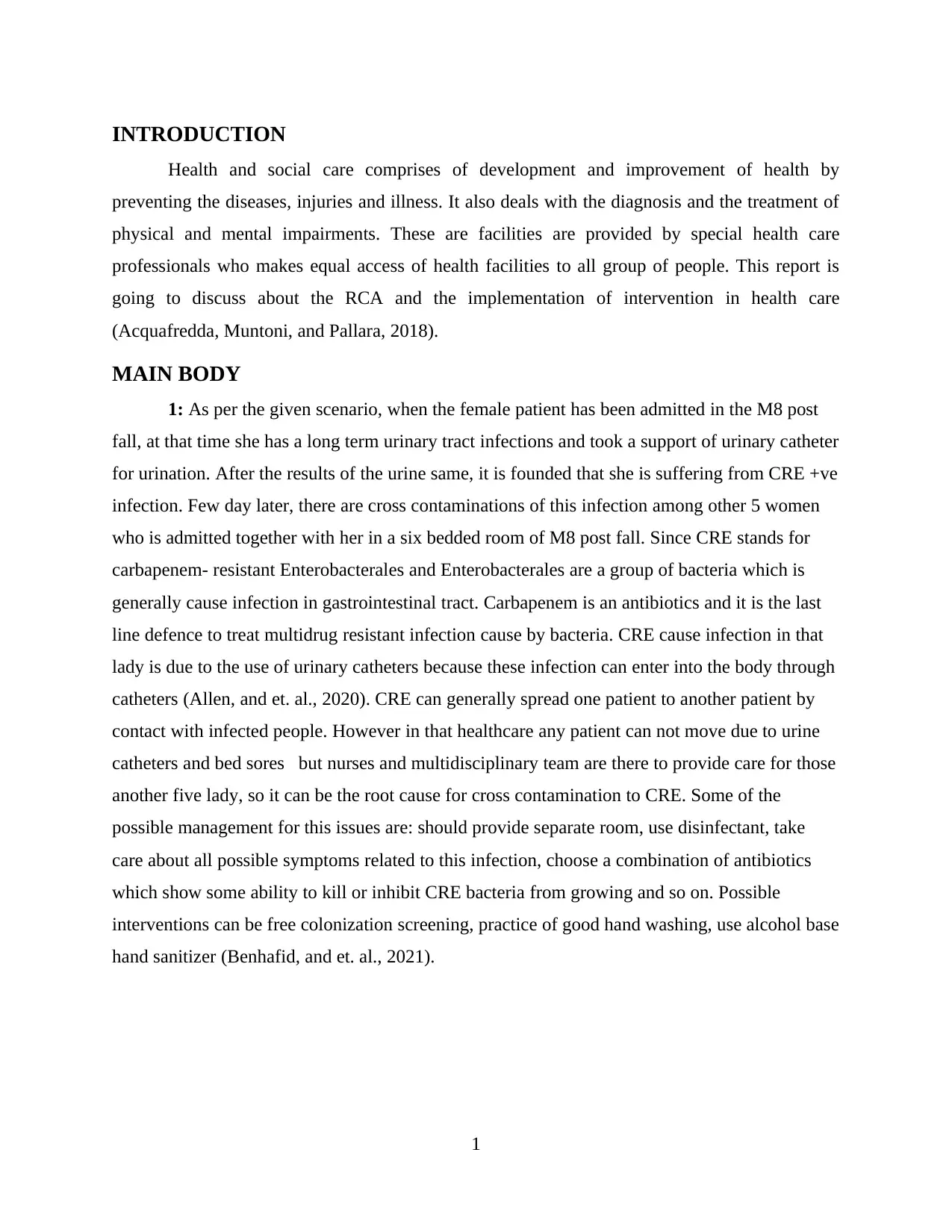
INTRODUCTION
Health and social care comprises of development and improvement of health by
preventing the diseases, injuries and illness. It also deals with the diagnosis and the treatment of
physical and mental impairments. These are facilities are provided by special health care
professionals who makes equal access of health facilities to all group of people. This report is
going to discuss about the RCA and the implementation of intervention in health care
(Acquafredda, Muntoni, and Pallara, 2018).
MAIN BODY
1: As per the given scenario, when the female patient has been admitted in the M8 post
fall, at that time she has a long term urinary tract infections and took a support of urinary catheter
for urination. After the results of the urine same, it is founded that she is suffering from CRE +ve
infection. Few day later, there are cross contaminations of this infection among other 5 women
who is admitted together with her in a six bedded room of M8 post fall. Since CRE stands for
carbapenem- resistant Enterobacterales and Enterobacterales are a group of bacteria which is
generally cause infection in gastrointestinal tract. Carbapenem is an antibiotics and it is the last
line defence to treat multidrug resistant infection cause by bacteria. CRE cause infection in that
lady is due to the use of urinary catheters because these infection can enter into the body through
catheters (Allen, and et. al., 2020). CRE can generally spread one patient to another patient by
contact with infected people. However in that healthcare any patient can not move due to urine
catheters and bed sores but nurses and multidisciplinary team are there to provide care for those
another five lady, so it can be the root cause for cross contamination to CRE. Some of the
possible management for this issues are: should provide separate room, use disinfectant, take
care about all possible symptoms related to this infection, choose a combination of antibiotics
which show some ability to kill or inhibit CRE bacteria from growing and so on. Possible
interventions can be free colonization screening, practice of good hand washing, use alcohol base
hand sanitizer (Benhafid, and et. al., 2021).
1
Health and social care comprises of development and improvement of health by
preventing the diseases, injuries and illness. It also deals with the diagnosis and the treatment of
physical and mental impairments. These are facilities are provided by special health care
professionals who makes equal access of health facilities to all group of people. This report is
going to discuss about the RCA and the implementation of intervention in health care
(Acquafredda, Muntoni, and Pallara, 2018).
MAIN BODY
1: As per the given scenario, when the female patient has been admitted in the M8 post
fall, at that time she has a long term urinary tract infections and took a support of urinary catheter
for urination. After the results of the urine same, it is founded that she is suffering from CRE +ve
infection. Few day later, there are cross contaminations of this infection among other 5 women
who is admitted together with her in a six bedded room of M8 post fall. Since CRE stands for
carbapenem- resistant Enterobacterales and Enterobacterales are a group of bacteria which is
generally cause infection in gastrointestinal tract. Carbapenem is an antibiotics and it is the last
line defence to treat multidrug resistant infection cause by bacteria. CRE cause infection in that
lady is due to the use of urinary catheters because these infection can enter into the body through
catheters (Allen, and et. al., 2020). CRE can generally spread one patient to another patient by
contact with infected people. However in that healthcare any patient can not move due to urine
catheters and bed sores but nurses and multidisciplinary team are there to provide care for those
another five lady, so it can be the root cause for cross contamination to CRE. Some of the
possible management for this issues are: should provide separate room, use disinfectant, take
care about all possible symptoms related to this infection, choose a combination of antibiotics
which show some ability to kill or inhibit CRE bacteria from growing and so on. Possible
interventions can be free colonization screening, practice of good hand washing, use alcohol base
hand sanitizer (Benhafid, and et. al., 2021).
1
⊘ This is a preview!⊘
Do you want full access?
Subscribe today to unlock all pages.

Trusted by 1+ million students worldwide
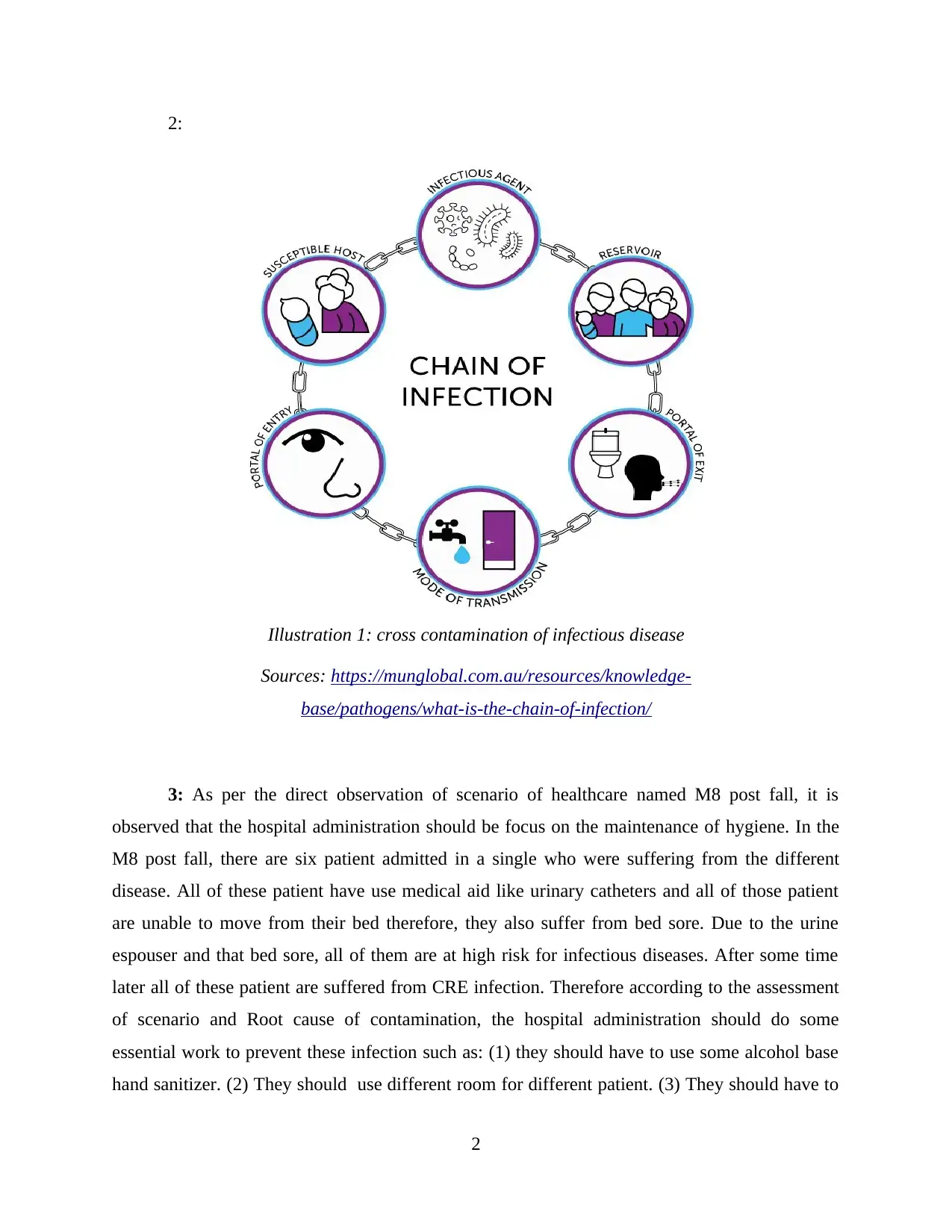
2:
3: As per the direct observation of scenario of healthcare named M8 post fall, it is
observed that the hospital administration should be focus on the maintenance of hygiene. In the
M8 post fall, there are six patient admitted in a single who were suffering from the different
disease. All of these patient have use medical aid like urinary catheters and all of those patient
are unable to move from their bed therefore, they also suffer from bed sore. Due to the urine
espouser and that bed sore, all of them are at high risk for infectious diseases. After some time
later all of these patient are suffered from CRE infection. Therefore according to the assessment
of scenario and Root cause of contamination, the hospital administration should do some
essential work to prevent these infection such as: (1) they should have to use some alcohol base
hand sanitizer. (2) They should use different room for different patient. (3) They should have to
2
Illustration 1: cross contamination of infectious disease
Sources: https://munglobal.com.au/resources/knowledge-
base/pathogens/what-is-the-chain-of-infection/
3: As per the direct observation of scenario of healthcare named M8 post fall, it is
observed that the hospital administration should be focus on the maintenance of hygiene. In the
M8 post fall, there are six patient admitted in a single who were suffering from the different
disease. All of these patient have use medical aid like urinary catheters and all of those patient
are unable to move from their bed therefore, they also suffer from bed sore. Due to the urine
espouser and that bed sore, all of them are at high risk for infectious diseases. After some time
later all of these patient are suffered from CRE infection. Therefore according to the assessment
of scenario and Root cause of contamination, the hospital administration should do some
essential work to prevent these infection such as: (1) they should have to use some alcohol base
hand sanitizer. (2) They should use different room for different patient. (3) They should have to
2
Illustration 1: cross contamination of infectious disease
Sources: https://munglobal.com.au/resources/knowledge-
base/pathogens/what-is-the-chain-of-infection/
Paraphrase This Document
Need a fresh take? Get an instant paraphrase of this document with our AI Paraphraser
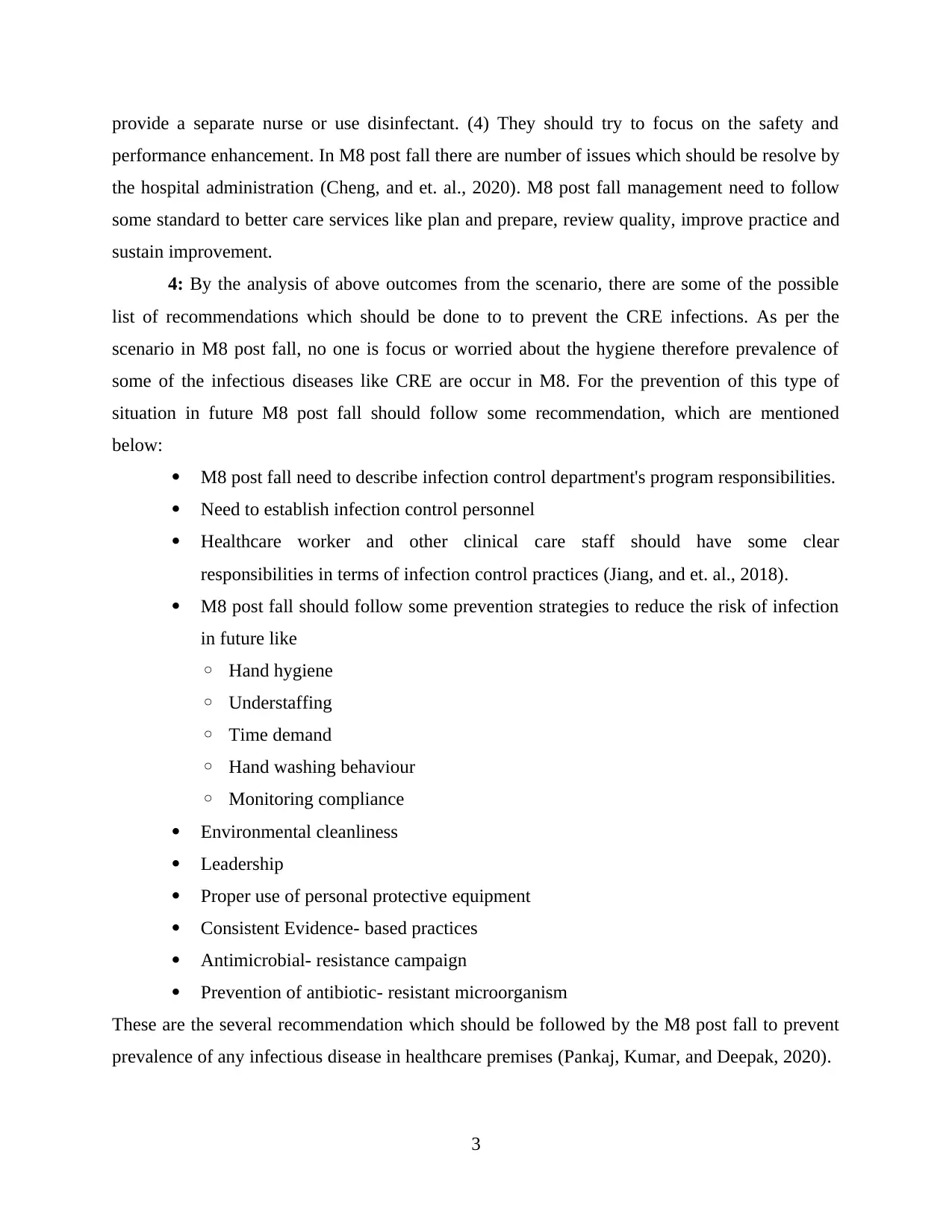
provide a separate nurse or use disinfectant. (4) They should try to focus on the safety and
performance enhancement. In M8 post fall there are number of issues which should be resolve by
the hospital administration (Cheng, and et. al., 2020). M8 post fall management need to follow
some standard to better care services like plan and prepare, review quality, improve practice and
sustain improvement.
4: By the analysis of above outcomes from the scenario, there are some of the possible
list of recommendations which should be done to to prevent the CRE infections. As per the
scenario in M8 post fall, no one is focus or worried about the hygiene therefore prevalence of
some of the infectious diseases like CRE are occur in M8. For the prevention of this type of
situation in future M8 post fall should follow some recommendation, which are mentioned
below:
M8 post fall need to describe infection control department's program responsibilities.
Need to establish infection control personnel
Healthcare worker and other clinical care staff should have some clear
responsibilities in terms of infection control practices (Jiang, and et. al., 2018).
M8 post fall should follow some prevention strategies to reduce the risk of infection
in future like
◦ Hand hygiene
◦ Understaffing
◦ Time demand
◦ Hand washing behaviour
◦ Monitoring compliance
Environmental cleanliness
Leadership
Proper use of personal protective equipment
Consistent Evidence- based practices
Antimicrobial- resistance campaign
Prevention of antibiotic- resistant microorganism
These are the several recommendation which should be followed by the M8 post fall to prevent
prevalence of any infectious disease in healthcare premises (Pankaj, Kumar, and Deepak, 2020).
3
performance enhancement. In M8 post fall there are number of issues which should be resolve by
the hospital administration (Cheng, and et. al., 2020). M8 post fall management need to follow
some standard to better care services like plan and prepare, review quality, improve practice and
sustain improvement.
4: By the analysis of above outcomes from the scenario, there are some of the possible
list of recommendations which should be done to to prevent the CRE infections. As per the
scenario in M8 post fall, no one is focus or worried about the hygiene therefore prevalence of
some of the infectious diseases like CRE are occur in M8. For the prevention of this type of
situation in future M8 post fall should follow some recommendation, which are mentioned
below:
M8 post fall need to describe infection control department's program responsibilities.
Need to establish infection control personnel
Healthcare worker and other clinical care staff should have some clear
responsibilities in terms of infection control practices (Jiang, and et. al., 2018).
M8 post fall should follow some prevention strategies to reduce the risk of infection
in future like
◦ Hand hygiene
◦ Understaffing
◦ Time demand
◦ Hand washing behaviour
◦ Monitoring compliance
Environmental cleanliness
Leadership
Proper use of personal protective equipment
Consistent Evidence- based practices
Antimicrobial- resistance campaign
Prevention of antibiotic- resistant microorganism
These are the several recommendation which should be followed by the M8 post fall to prevent
prevalence of any infectious disease in healthcare premises (Pankaj, Kumar, and Deepak, 2020).
3
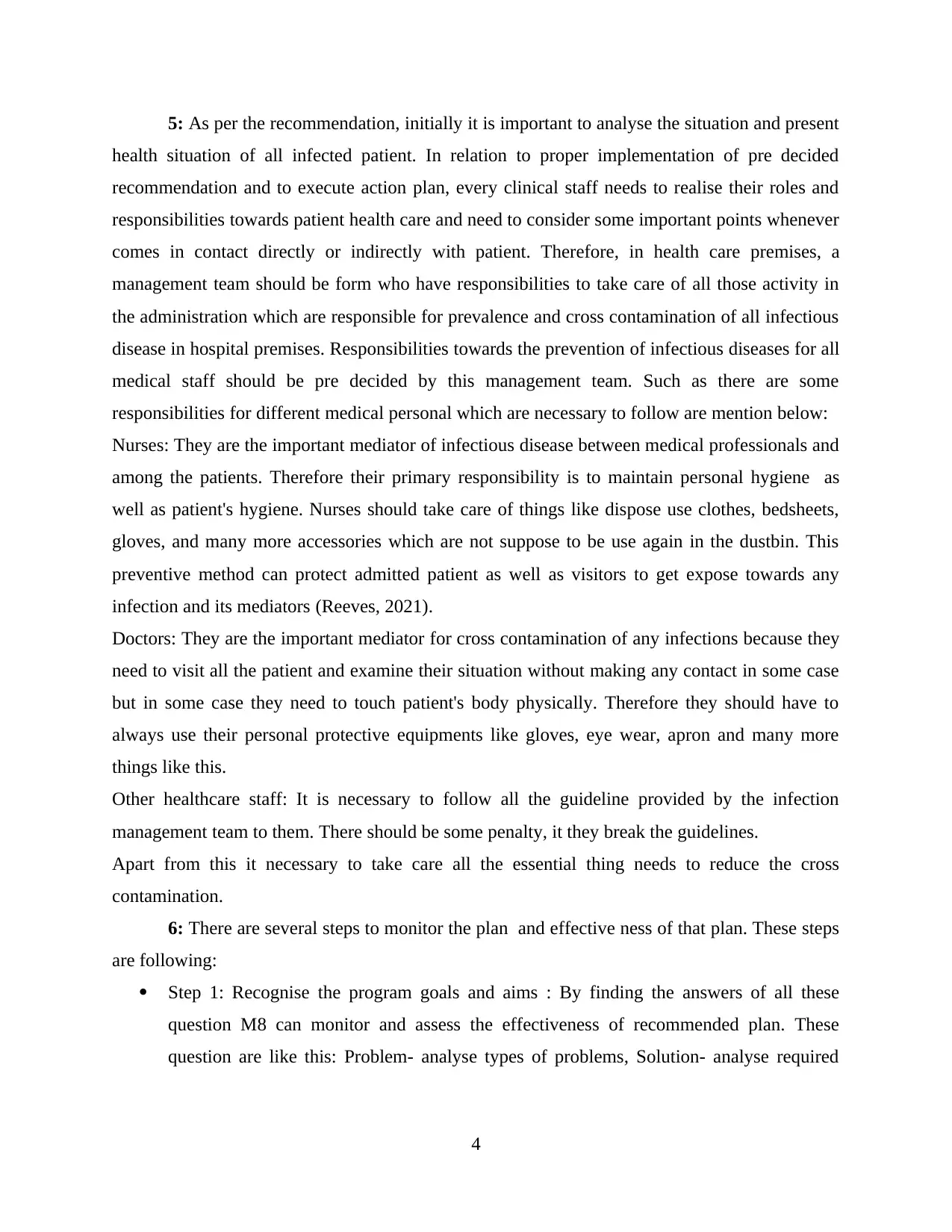
5: As per the recommendation, initially it is important to analyse the situation and present
health situation of all infected patient. In relation to proper implementation of pre decided
recommendation and to execute action plan, every clinical staff needs to realise their roles and
responsibilities towards patient health care and need to consider some important points whenever
comes in contact directly or indirectly with patient. Therefore, in health care premises, a
management team should be form who have responsibilities to take care of all those activity in
the administration which are responsible for prevalence and cross contamination of all infectious
disease in hospital premises. Responsibilities towards the prevention of infectious diseases for all
medical staff should be pre decided by this management team. Such as there are some
responsibilities for different medical personal which are necessary to follow are mention below:
Nurses: They are the important mediator of infectious disease between medical professionals and
among the patients. Therefore their primary responsibility is to maintain personal hygiene as
well as patient's hygiene. Nurses should take care of things like dispose use clothes, bedsheets,
gloves, and many more accessories which are not suppose to be use again in the dustbin. This
preventive method can protect admitted patient as well as visitors to get expose towards any
infection and its mediators (Reeves, 2021).
Doctors: They are the important mediator for cross contamination of any infections because they
need to visit all the patient and examine their situation without making any contact in some case
but in some case they need to touch patient's body physically. Therefore they should have to
always use their personal protective equipments like gloves, eye wear, apron and many more
things like this.
Other healthcare staff: It is necessary to follow all the guideline provided by the infection
management team to them. There should be some penalty, it they break the guidelines.
Apart from this it necessary to take care all the essential thing needs to reduce the cross
contamination.
6: There are several steps to monitor the plan and effective ness of that plan. These steps
are following:
Step 1: Recognise the program goals and aims : By finding the answers of all these
question M8 can monitor and assess the effectiveness of recommended plan. These
question are like this: Problem- analyse types of problems, Solution- analyse required
4
health situation of all infected patient. In relation to proper implementation of pre decided
recommendation and to execute action plan, every clinical staff needs to realise their roles and
responsibilities towards patient health care and need to consider some important points whenever
comes in contact directly or indirectly with patient. Therefore, in health care premises, a
management team should be form who have responsibilities to take care of all those activity in
the administration which are responsible for prevalence and cross contamination of all infectious
disease in hospital premises. Responsibilities towards the prevention of infectious diseases for all
medical staff should be pre decided by this management team. Such as there are some
responsibilities for different medical personal which are necessary to follow are mention below:
Nurses: They are the important mediator of infectious disease between medical professionals and
among the patients. Therefore their primary responsibility is to maintain personal hygiene as
well as patient's hygiene. Nurses should take care of things like dispose use clothes, bedsheets,
gloves, and many more accessories which are not suppose to be use again in the dustbin. This
preventive method can protect admitted patient as well as visitors to get expose towards any
infection and its mediators (Reeves, 2021).
Doctors: They are the important mediator for cross contamination of any infections because they
need to visit all the patient and examine their situation without making any contact in some case
but in some case they need to touch patient's body physically. Therefore they should have to
always use their personal protective equipments like gloves, eye wear, apron and many more
things like this.
Other healthcare staff: It is necessary to follow all the guideline provided by the infection
management team to them. There should be some penalty, it they break the guidelines.
Apart from this it necessary to take care all the essential thing needs to reduce the cross
contamination.
6: There are several steps to monitor the plan and effective ness of that plan. These steps
are following:
Step 1: Recognise the program goals and aims : By finding the answers of all these
question M8 can monitor and assess the effectiveness of recommended plan. These
question are like this: Problem- analyse types of problems, Solution- analyse required
4
⊘ This is a preview!⊘
Do you want full access?
Subscribe today to unlock all pages.

Trusted by 1+ million students worldwide
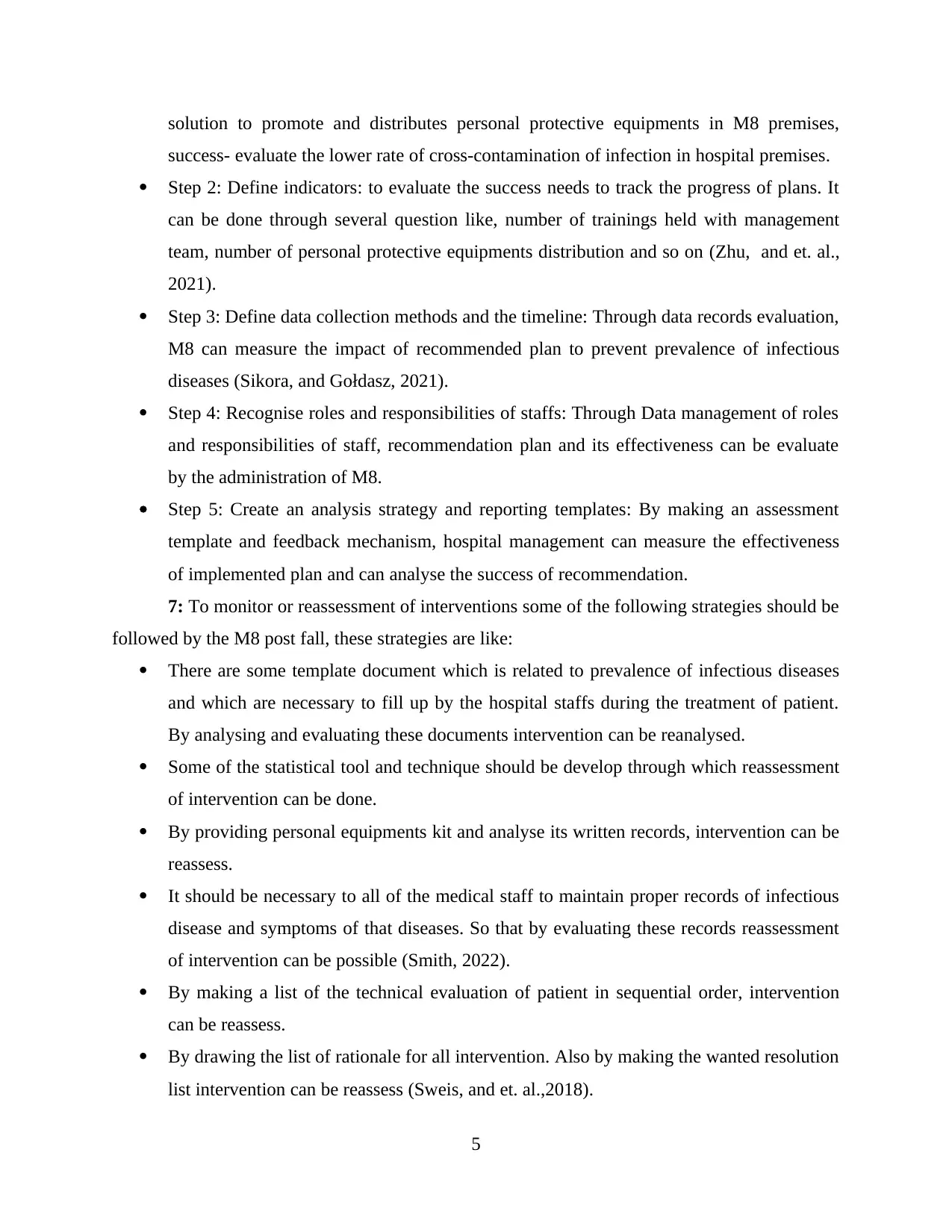
solution to promote and distributes personal protective equipments in M8 premises,
success- evaluate the lower rate of cross-contamination of infection in hospital premises.
Step 2: Define indicators: to evaluate the success needs to track the progress of plans. It
can be done through several question like, number of trainings held with management
team, number of personal protective equipments distribution and so on (Zhu, and et. al.,
2021).
Step 3: Define data collection methods and the timeline: Through data records evaluation,
M8 can measure the impact of recommended plan to prevent prevalence of infectious
diseases (Sikora, and Gołdasz, 2021).
Step 4: Recognise roles and responsibilities of staffs: Through Data management of roles
and responsibilities of staff, recommendation plan and its effectiveness can be evaluate
by the administration of M8.
Step 5: Create an analysis strategy and reporting templates: By making an assessment
template and feedback mechanism, hospital management can measure the effectiveness
of implemented plan and can analyse the success of recommendation.
7: To monitor or reassessment of interventions some of the following strategies should be
followed by the M8 post fall, these strategies are like:
There are some template document which is related to prevalence of infectious diseases
and which are necessary to fill up by the hospital staffs during the treatment of patient.
By analysing and evaluating these documents intervention can be reanalysed.
Some of the statistical tool and technique should be develop through which reassessment
of intervention can be done.
By providing personal equipments kit and analyse its written records, intervention can be
reassess.
It should be necessary to all of the medical staff to maintain proper records of infectious
disease and symptoms of that diseases. So that by evaluating these records reassessment
of intervention can be possible (Smith, 2022).
By making a list of the technical evaluation of patient in sequential order, intervention
can be reassess.
By drawing the list of rationale for all intervention. Also by making the wanted resolution
list intervention can be reassess (Sweis, and et. al.,2018).
5
success- evaluate the lower rate of cross-contamination of infection in hospital premises.
Step 2: Define indicators: to evaluate the success needs to track the progress of plans. It
can be done through several question like, number of trainings held with management
team, number of personal protective equipments distribution and so on (Zhu, and et. al.,
2021).
Step 3: Define data collection methods and the timeline: Through data records evaluation,
M8 can measure the impact of recommended plan to prevent prevalence of infectious
diseases (Sikora, and Gołdasz, 2021).
Step 4: Recognise roles and responsibilities of staffs: Through Data management of roles
and responsibilities of staff, recommendation plan and its effectiveness can be evaluate
by the administration of M8.
Step 5: Create an analysis strategy and reporting templates: By making an assessment
template and feedback mechanism, hospital management can measure the effectiveness
of implemented plan and can analyse the success of recommendation.
7: To monitor or reassessment of interventions some of the following strategies should be
followed by the M8 post fall, these strategies are like:
There are some template document which is related to prevalence of infectious diseases
and which are necessary to fill up by the hospital staffs during the treatment of patient.
By analysing and evaluating these documents intervention can be reanalysed.
Some of the statistical tool and technique should be develop through which reassessment
of intervention can be done.
By providing personal equipments kit and analyse its written records, intervention can be
reassess.
It should be necessary to all of the medical staff to maintain proper records of infectious
disease and symptoms of that diseases. So that by evaluating these records reassessment
of intervention can be possible (Smith, 2022).
By making a list of the technical evaluation of patient in sequential order, intervention
can be reassess.
By drawing the list of rationale for all intervention. Also by making the wanted resolution
list intervention can be reassess (Sweis, and et. al.,2018).
5
Paraphrase This Document
Need a fresh take? Get an instant paraphrase of this document with our AI Paraphraser
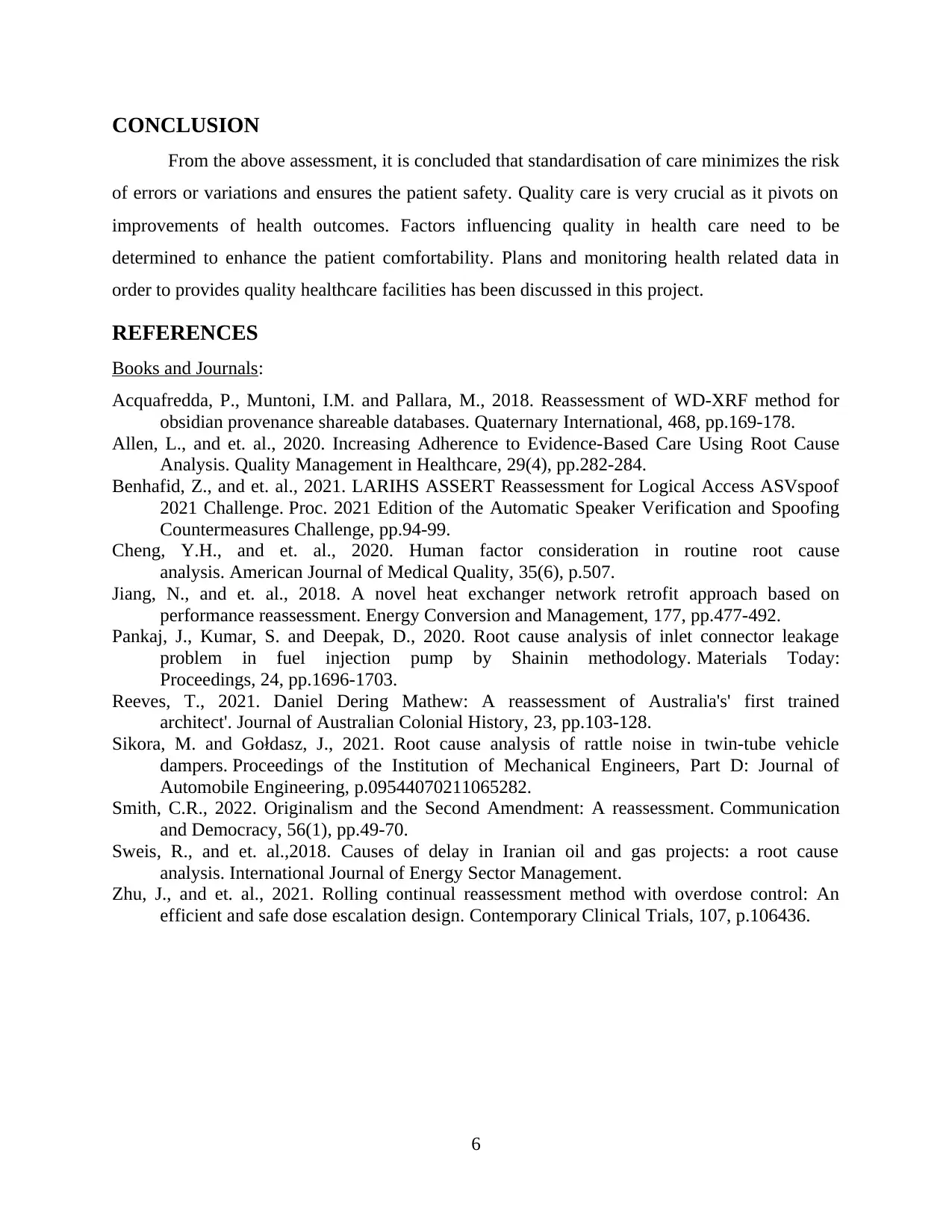
CONCLUSION
From the above assessment, it is concluded that standardisation of care minimizes the risk
of errors or variations and ensures the patient safety. Quality care is very crucial as it pivots on
improvements of health outcomes. Factors influencing quality in health care need to be
determined to enhance the patient comfortability. Plans and monitoring health related data in
order to provides quality healthcare facilities has been discussed in this project.
REFERENCES
Books and Journals:
Acquafredda, P., Muntoni, I.M. and Pallara, M., 2018. Reassessment of WD-XRF method for
obsidian provenance shareable databases. Quaternary International, 468, pp.169-178.
Allen, L., and et. al., 2020. Increasing Adherence to Evidence-Based Care Using Root Cause
Analysis. Quality Management in Healthcare, 29(4), pp.282-284.
Benhafid, Z., and et. al., 2021. LARIHS ASSERT Reassessment for Logical Access ASVspoof
2021 Challenge. Proc. 2021 Edition of the Automatic Speaker Verification and Spoofing
Countermeasures Challenge, pp.94-99.
Cheng, Y.H., and et. al., 2020. Human factor consideration in routine root cause
analysis. American Journal of Medical Quality, 35(6), p.507.
Jiang, N., and et. al., 2018. A novel heat exchanger network retrofit approach based on
performance reassessment. Energy Conversion and Management, 177, pp.477-492.
Pankaj, J., Kumar, S. and Deepak, D., 2020. Root cause analysis of inlet connector leakage
problem in fuel injection pump by Shainin methodology. Materials Today:
Proceedings, 24, pp.1696-1703.
Reeves, T., 2021. Daniel Dering Mathew: A reassessment of Australia's' first trained
architect'. Journal of Australian Colonial History, 23, pp.103-128.
Sikora, M. and Gołdasz, J., 2021. Root cause analysis of rattle noise in twin-tube vehicle
dampers. Proceedings of the Institution of Mechanical Engineers, Part D: Journal of
Automobile Engineering, p.09544070211065282.
Smith, C.R., 2022. Originalism and the Second Amendment: A reassessment. Communication
and Democracy, 56(1), pp.49-70.
Sweis, R., and et. al.,2018. Causes of delay in Iranian oil and gas projects: a root cause
analysis. International Journal of Energy Sector Management.
Zhu, J., and et. al., 2021. Rolling continual reassessment method with overdose control: An
efficient and safe dose escalation design. Contemporary Clinical Trials, 107, p.106436.
6
From the above assessment, it is concluded that standardisation of care minimizes the risk
of errors or variations and ensures the patient safety. Quality care is very crucial as it pivots on
improvements of health outcomes. Factors influencing quality in health care need to be
determined to enhance the patient comfortability. Plans and monitoring health related data in
order to provides quality healthcare facilities has been discussed in this project.
REFERENCES
Books and Journals:
Acquafredda, P., Muntoni, I.M. and Pallara, M., 2018. Reassessment of WD-XRF method for
obsidian provenance shareable databases. Quaternary International, 468, pp.169-178.
Allen, L., and et. al., 2020. Increasing Adherence to Evidence-Based Care Using Root Cause
Analysis. Quality Management in Healthcare, 29(4), pp.282-284.
Benhafid, Z., and et. al., 2021. LARIHS ASSERT Reassessment for Logical Access ASVspoof
2021 Challenge. Proc. 2021 Edition of the Automatic Speaker Verification and Spoofing
Countermeasures Challenge, pp.94-99.
Cheng, Y.H., and et. al., 2020. Human factor consideration in routine root cause
analysis. American Journal of Medical Quality, 35(6), p.507.
Jiang, N., and et. al., 2018. A novel heat exchanger network retrofit approach based on
performance reassessment. Energy Conversion and Management, 177, pp.477-492.
Pankaj, J., Kumar, S. and Deepak, D., 2020. Root cause analysis of inlet connector leakage
problem in fuel injection pump by Shainin methodology. Materials Today:
Proceedings, 24, pp.1696-1703.
Reeves, T., 2021. Daniel Dering Mathew: A reassessment of Australia's' first trained
architect'. Journal of Australian Colonial History, 23, pp.103-128.
Sikora, M. and Gołdasz, J., 2021. Root cause analysis of rattle noise in twin-tube vehicle
dampers. Proceedings of the Institution of Mechanical Engineers, Part D: Journal of
Automobile Engineering, p.09544070211065282.
Smith, C.R., 2022. Originalism and the Second Amendment: A reassessment. Communication
and Democracy, 56(1), pp.49-70.
Sweis, R., and et. al.,2018. Causes of delay in Iranian oil and gas projects: a root cause
analysis. International Journal of Energy Sector Management.
Zhu, J., and et. al., 2021. Rolling continual reassessment method with overdose control: An
efficient and safe dose escalation design. Contemporary Clinical Trials, 107, p.106436.
6
1 out of 8
Related Documents
Your All-in-One AI-Powered Toolkit for Academic Success.
+13062052269
info@desklib.com
Available 24*7 on WhatsApp / Email
![[object Object]](/_next/static/media/star-bottom.7253800d.svg)
Unlock your academic potential
Copyright © 2020–2025 A2Z Services. All Rights Reserved. Developed and managed by ZUCOL.





